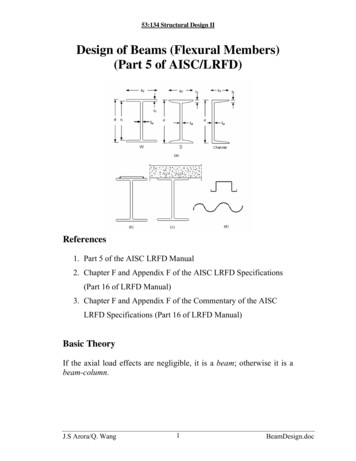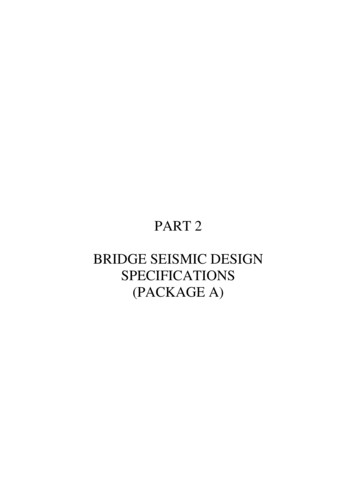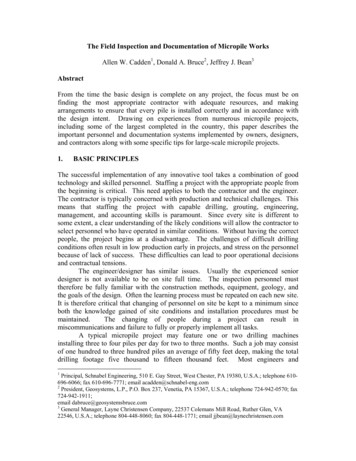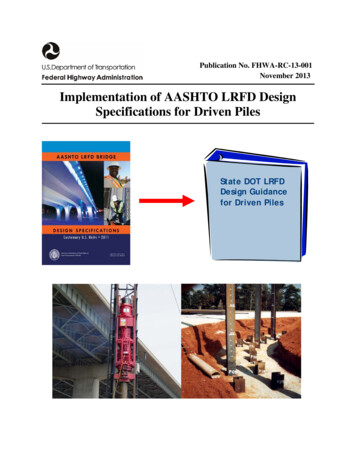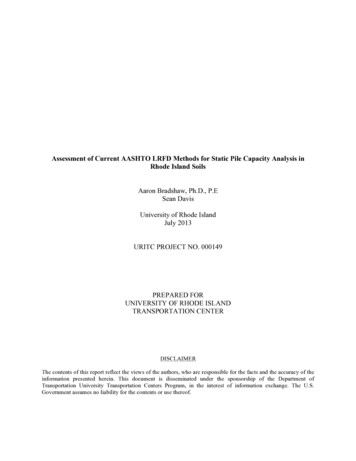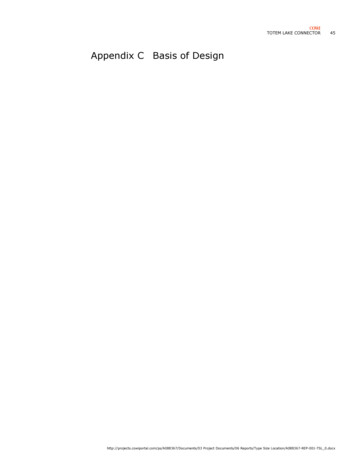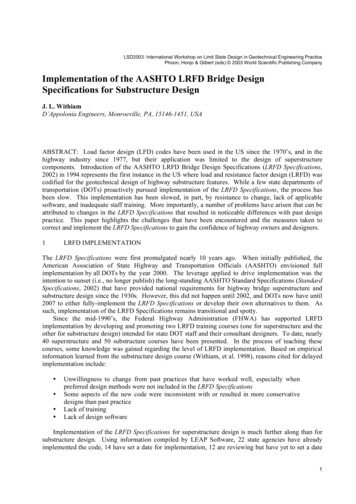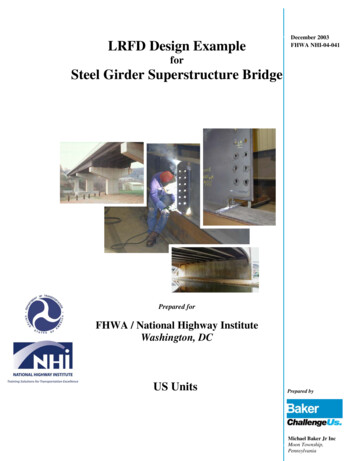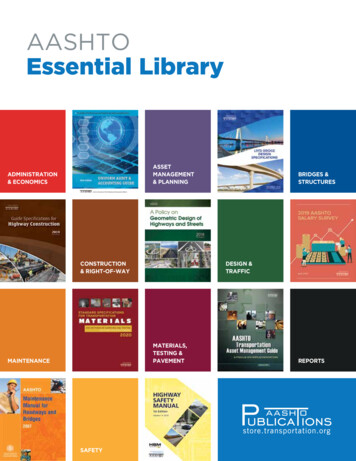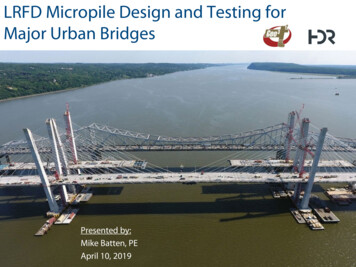
Transcription
LRFD Micropile Design and Testing forMajor Urban BridgesPresented by:Mike Batten, PEApril 10, 20191
NOTEVideo or photography is not allowed during this presentation.The information (electronic or hardcopy) contained in thispresentation is intended for the exclusive use of this presentationand may contain information that is confidential or sensitive.Dissemination, forwarding, printing, or copying is strictlyprohibited. Information regarding the New NY Bridge Project thatcan be circulated is available on NewNYBridge.comPhotos courtesy of New York State Thruway Authority.2
Agenda Use of Micropiles in Bridge Design Use of Micropiles on Governor Mario M. CuomoBridge General Design & Detailing Structural Design Geotechnical Design Pier 1 Eastbound Installation Static Load Testing3
LRFD Micropile Design and Testing for Major Urban BridgesUse of Micropiles in Bridge Design4
Use of Micropiles in Bridge Design5
Use of Micropiles in Bridge Design Micropiles require significantly less head room to install Casings are standardized (typically flush joint) Minimal reinforcing required (centralized bar or bars) Cost effective when welded splices are costly Allows for easy installation when access is an issue(especially for battered piles)6
Use of Micropiles in Bridge Design FHWA Micropile Design and Construction is an importantreference to consider all design elements. Non-battered micropiles (in the case of Pier 1EB) resist largelateral loads and bending moments Location of flush joints and central bar splice locations mustbe evaluated Section loss due to corrosion to be considered(Structural/Geotechnical coordination)7
Use of Micropiles in Bridge Design General Details of a Micropile8
LRFD Micropile Design and Testing for Major Urban BridgesUse of Micropiles on GovernorMario M. Cuomo Bridge9
Use of Micropiles on Governor Mario M. Cuomo BridgeProject Overview Existing Tappan Zee Bridge in New York replaced byGovernor Mario M. Cuomo Bridge Design-Build Contract awarded to Tappan Zee Constructors,LLC HDR – Lead Designer New eastbound bridge abutment was coincident with theexisting bridge on the western approach for the first fourspans New Pier 1 eastbound located entirely underneath theexisting bridge10
Use of Micropiles on Governor Mario M. Cuomo BridgeBenefit of Micropiles Demolition of the existing bridge was on the critical path tosubstantial completion Project schedule would see benefit from constructing newbridge foundation at Pier 1 Eastbound prior to demolition ofthe existing bridge Low headroom conditions on the existing landing at Pier 1Eastbound prevented the use of driven piles as planned Micropiles could be installed in low headroom conditionunderneath existing bridge prior to demolition, expeditingthe new bridge construction schedule11
LRFD Micropile Design and Testing for Major Urban BridgesDesign & Detailing12
Design & DetailingPile Layout: 21 H-Piles replaced by 35 MicropilesNDC0137 PILE LAYOUTRFC PILE LAYOUT13
Design & DetailingMicropile Details 13.375” outer diameter of outer casing - ½” thick permanent steel casing(Spliced) 10.75” outer diameter of inner casing – ½” thick permanent steel casing 1/8” corrosion loss for outer surface (full length) #18 – 75 ksi galvanized all thread rod (Spliced) Minimum rock socket 13 feet (not including plunge length) Minimum plunge length 1 foot14
Design & DetailingStructural Details Pier 1 Eastbound Section A-A:double casingElevation15
Design & DetailingStructural Details Pier 1 Eastbound Section A-A:double casing Section B-B: singleouter casingElevation16
Design & DetailingStructural Details Pier 1 Eastbound Section A-A:double casing Section B-B: singleouter casing Section C-C:uncased bondedzoneElevation17
Design & DetailingStructural DetailsSections18
Design & DetailingBar Centralizers: Corrosion Protection19
Design & DetailingFlush Joint Threaded Connection When Micropiles are designed to resist significant flexure, the flush jointthreaded connection must transfer moment capacity of pipe. Due to corrosive soils at the site, the section loss showed that the threadedsplice would see a loss in force transfer Location of splices were moved to be outside areas of maximum moment.20
Design & DetailingFlush Joint Threaded Connection21
Design & DetailingDesign Steel Grade for Casing API Grade N80 casing widely available ateconomical cost using mill secondary steel API Grade N80 casing has minimum 80 ksi yieldstrength Mill secondary casing is unused but rejected for useas oilfield pipe because it does not mean one ormore API N80 specification requirements - typically it is out of spec for geometrical tolerance Mill certifications for mill secondary casing notalways available22
Design & DetailingMill Secondary vs. Prime Casing Buy America provisions for federally fundedprojects may prevent use of mill secondary casing ifthe casing cannot be traced to a US steel mill If mill certifications are not available, coupon testson each lot of casing can be done to verify grade ofsteel 50 and 60 ksi prime casing is more readily availableand can be specified according to ASTM A252(Modified) rather than API N80 for comparablepricing23
LRFD Micropile Design and Testing for Major Urban BridgesStructural Design24
Structural Design Pile Required Embedment Length Top Plate Size and Thickness Plate to the Casing Connection Casing Portion of Pile Bonded Zone25
Structural Design Casing Portion of Pile Design based on moment andaxial forces per AASHTOSections 5 and 6 Use ½ thickness at threadedjoints Consider corrosion Need to specify “No SpliceZone” or Double Casing26
Structural Design Bonded Zone Start of bonded zone - Zeromoment in micropile27
Structural Design Bonded Zone Length of bonded zone Min. length to satisfy axial force Adequate bond length for center bar Plunge length - embedment depth ofcasing into bearing strata (typically rock) - reduces bending stress on weaker uncasedsection at soil/rock interface Simple concrete column design28
LRFD Micropile Design and Testing for Major Urban BridgesGeotechnical Design Criteria29
Geotechnical Design CriteriaGeotechnical Resistance Factors Strength Limit State: Resistance factor of 0.7 (corresponding to staticload testing) for geotechnical axial compressive resistance in accordancewith AASHTO Table 10.5.5.2.5-1. Bond length preliminary estimates based on AASHTO presumptivevalues. Resistance factor of 0.55 used for presumptive bond values. Extreme Limit State: Resistance factor of 1.0 was selected for axialgeotechnical compressive resistance in accordance with AASHTOSection 10.5.5.3.2.30
Geotechnical Design CriteriaGeotechnical Resistance Type A micropiles as defined by AASHTO Section 10.9.1 (tremie groutplacement under gravity, no pressure grouting). Axial resistance from side friction in the rock socket only. End bearing resistance ignored for geotechnical resistance.31
Geotechnical Design CriteriaGeotechnical Resistance A best estimate value of 150 psi used for grout-to-ground bond nominalresistance for Type A micropiles in Sandstone which ranges from 75 psito 250 psi according to AASHTO Table C10.9.3.5.2-1. Required nominal geotechnical axial resistance verified in the axial loadtesting program. Lateral loads resisted by overburden soils above top of rock socket asdetermined with FB MultiPier modeling.32
LRFD Micropile Design and Testing for Major Urban BridgesPier 1 Eastbound Installation33
Pier 1 Eastbound InstallationLimited Overhead Room34
InstallationRotary Duplex Casing35
InstallationLead Casing with Cutting Teeth36
InstallationAir Hammer Drilling37
LRFD Micropile Design and Testing for Major Urban BridgesStatic Load Testing38
Static Load TestingStatic Axial Load Testing AASHTO requires at least 1 verification test, and 5% of all micropiles tobe proof tested for axial compression. Performance test requires longer hold increments to evaluate creeppotential and testing to the required nominal resistance at a minimum. Proof testing is only required up to the max factored design load. Uplift load testing often planned instead of compression due tosimplicity of operation and no need for end bearing resistance. Uplift and compression load tests were done at Pier 1 EB.39
Static Load TestingStatic Axial Uplift Load Testing40
Static Load TestingStatic Axial Uplift Load Testing41
Static Load TestingStatic Axial Compression Load Testing42
Static Load TestingStatic Axial Compression Load Testing43
Static Load TestingStatic Lateral Load Testing Lateral load testing was performed to meet contract requirements, notoften done in practice. The goal of the test was to verify that pile head displacement was similarto the predicted pile head displacement in a free head condition in FBMultiPier, and the prediction was very good based on the Sand (O’Neill)p-y curves. Testing performed by pushing apart two micropiles, very simple loadframe.44
Static Load TestingStatic Lateral Load Testing45
Static Load TestingStatic Lateral Load Testing46
QUESTIONS?
FHWA Micropile Design and Construction is an important reference to consider all design elements. Non-battered micropiles (in the case of Pier 1EB) resist large lateral loads and bending moments Location of flush joints and central bar splice locations must be evaluated Section loss due to corrosion to be considered
